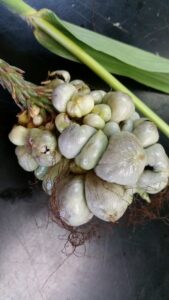The Rutgers Agrivoltaics Program is a multidisciplinary group of Rutgers faculty and staff committed to designing and conducting applied agrivoltaics research and outreach for stakeholders in New Jersey and throughout the region.
The Rutgers Agrivoltaics Program (RAP) was initiated over 3 years ago with the signing and passage of the Dual Use Solar Act by the New Jersey legislature. In 2023, Agrivoltaics research installations were established at three Rutgers-New Jersey Agricultural Experiment Stations (NJAES). One at the Clifford E. and Melda C. Snyder Research and Extension Farm in Pittstown, NJ; one at the Animal Farm on the Rutgers New Brunswick (SEBS) Campus, and one at the Rutgers Agricultural Research and Extension Center (RAREC) near Bridgeton, NJ. Members of the Rutgers RAP Team in collaboration the New Jersey Board of Public Utilities, NJ Department of Agriculture, and NJ-DEP are now in the process of implementing the Dual-Use Solar Energy Pilot Program.


The agrivoltaics research at the Rutgers Agricultural Research and Extension Center (RAREC) near Bridgeton, New Jersey has been designed to study the effects of agrivoltaic (AV) systems on the production of specialty crops and soybeans. This year eggplant, pepper, fresh-market tomatoes, and soybeans are being grown under three three different treatments: single-axis tracking array with one row of panels, single-axis tracking array with two rows of panels, and no panels (conventional production as a control) to determine the effects caused by the presence of the panels on specialty crop and soybean plant growth and yield.
At the Clifford E. and Melda C. Snyder Research and Extension Farm in Pittstown, NJ the effects of a single-axis tracking array with one row of panels on hay production is being studied.
At the Rutgers SEBS Campus Animal Farm in New Brunswick, New Jersey, which hosts equine and livestock facilities, the AV research has been designed to study pasture forage production and animal grazing patterns in combination with vertical bifacial solar panels.
For more information on the Rutgers Agrivoltaics Program and more AV resources please visit the new website by clicking here. Stakeholders interested in keeping up the what’s going on can now subscribe to the new website and have information send directly to their email account. Just go to our contact page and follow the instructions to subscribe!
The Rutgers Agrivoltaics Program in collaboration with the American Farmland Trust will be holding upcoming workshops for those stakeholders in New Jersey interested in learning more. Please click here for more information on these upcoming events.

